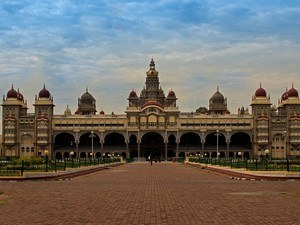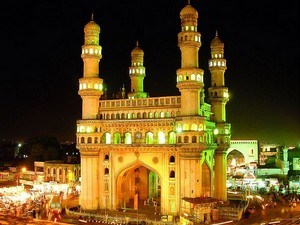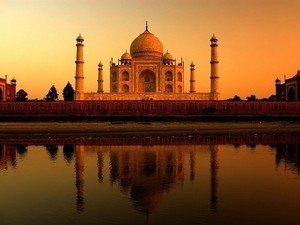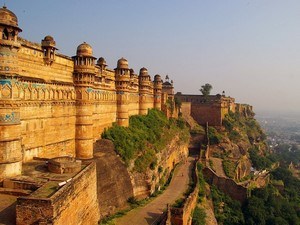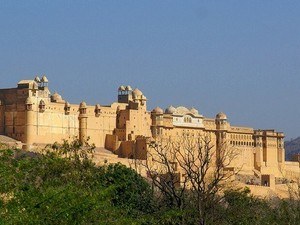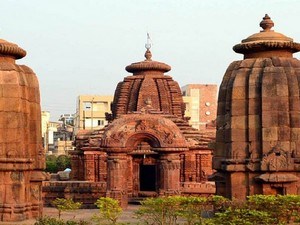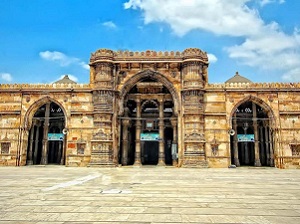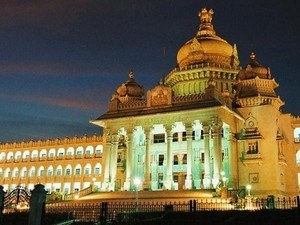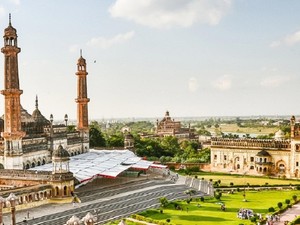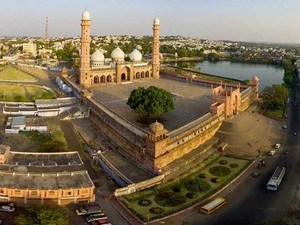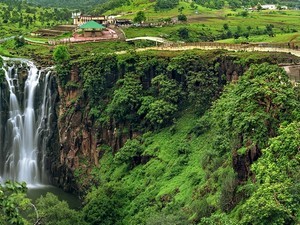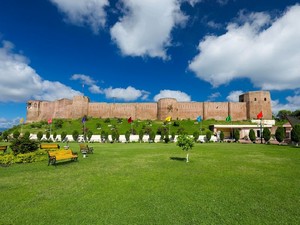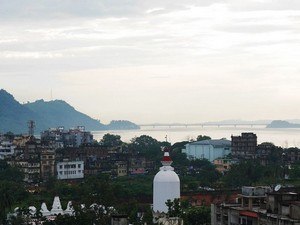1
DAY 1 : HALF-DAY DELHI SIGHTSEEING
DAY 1 : HALF-DAY DELHI SIGHTSEEING
 Sightseeing
Sightseeing
Leisure / No Sightseeing
At a distance of 3.5 km from New Delhi Railway Station, Jama Masjid or Masjid-i-jahan-Numa is located in the center of old Delhi near the famous Red Fort. This is one of the largest mosques in India and one of the last monuments built by Mughal Emperor Shah Jahan. It is one of the top places to visit in Delhi city and also among the top historical sites in Delhi.
Jama Masjid was commissioned by Shah Jahan between 1644 and 1656 at a cost of 1 million rupees. This mosque was constructed with the efforts of more than 5,000 workers. The Masjid was completed under the supervision of Saadullah Khan, the Prime Minister of Shah Jahan and was inaugurated by an imam from Bukhara, present-day Uzbekistan. After the British victory in Revolt of 1857, they occupied the mosque and stationed their soldiers here.
The mosque has three large gates, four towers and two 40 m high minarets constructed using red sandstone and white marble. The mosque is built on a red sandstone porch, which is about .....
 Duration of visit: 1 Hour
Duration of visit: 1 Hour
 Timings: 7 AM to 12 PM and 1.30 PM t0 6.30 PM
Timings: 7 AM to 12 PM and 1.30 PM t0 6.30 PM
At a distance of 4 km from New Delhi Railway Station, The Red Fort or the Lal Qila is one of the best historical places in Delhi situated on the western bank of the River Yamuna. This grand fort is a UNESCO World Heritage Site in Delhi, from where the prime minister addresses the nation every year on Independence Day (15 August). It is located in the center of Delhi and houses a number of museums. It is one of the best places to visit in Delhi and also one of the top attractions you must include in Golden Triangle tour.
The Red Fort was built by Shah Jahan between 1638 and 1648. The Fort was built when Shah Jahan transferred his capital from Agra to Delhi. The fort is better planned than the Agra Fort and was the residence of the Mughal emperor of India for nearly 200 years, until 1857. It was originally called as Quila-i-Mubarak, meaning the blessed fort, as it was the royal .....
 Duration of visit: 2 Hours
Duration of visit: 2 Hours
 Timings: 6 AM to 6 PM on all days. Closed on Monday.
Timings: 6 AM to 6 PM on all days. Closed on Monday.
At a distance of 5 km from New Delhi Railway Station, Raj Ghat is a memorial dedicated to the Father of the Nation, Mahatma Gandhi located on the banks of Yamuna River in Old Delhi.
Raj Ghat is the last resting place of Mahatma Gandhi. The cremation of Mahatma Gandhi took place at the Raj Ghat on 31st January 1948, a day after his assassination. The memorial was designed by Vanu G. Bhuta, who intended it to reflect the simplicity of the Mahatma's life. It has won several awards for its architectural design.
The memorial stone of Mahatma Gandhi placed on a simple square platform made of black stone, with the words Hey Ram inscribed on it. It is left open to the sky while an eternal flame burns perpetually at one end. The road on which it is located is also known as the Mahatma Gandhi Road.
It is situated amidst a well maintained garden with fountains and numerous trees that give the area a serene atmosphere. Near the memorial, there are labeled trees planted by visiting .....
 Duration of visit: 30 Mins - 1 Hr
Duration of visit: 30 Mins - 1 Hr
 Timings: 5 AM to 7 PM
Timings: 5 AM to 7 PM
At a distance of 10 km from New Delhi Railway Station, Akshardham Temple or Swaminarayan Temple is located on the banks of River Yamuna near Nizamuddin Bridge in Delhi. The temple is included in the list of Seven Wonders of the 21st Century by the prestigious Reader's Digest magazine. It is one of best built temples in India and among must visit tourist places in Delhi. It also has been listed in the 2009 edition of the Guinness World Records book as the largest Hindu temple in the world.
Akshardham Temple is dedicated to Lord Swaminarayan. Akshardham means the adobe of the supreme lord and the temple is a fine example of the Hindu architecture. The complex is the second Akshardham complex in the country after the one at Gandhinagar in Gujarat.
The building was inspired and moderated by Pramukh Swami Maharaj who was the spiritual leader BAPS community. It was inaugurated in November 2005 by the President, Dr. APJ Abdul Kalam.
Spread over 100 acres, the temple complex is .....
 Duration of visit: 2 Hours
Duration of visit: 2 Hours
 Timings: 9.30 AM to 8 PM. Closed on Monday
Timings: 9.30 AM to 8 PM. Closed on Monday
2
DAY 2 : DELHI SIGHTSEEING
%%Itinerary_Title_Day2%%
At a distance of 15 km from New Delhi Railway Station, Qutub Minar is the magnificent tower of victory stands in the Qutub Complex located at Aurabindo Marg near Mehrauli in Delhi. Qutub is the highest tower in India and is an UNESCO World Heritage Site. It is among the must visit Delhi tourist places and one of the best heritage sites in Delhi city. It is also commonly featured in the promotion of Delhi Tourism.
Qutub-ud-Din Aibak laid the foundation of Minar in 1199 AD for the use of the Mu'zzin (crier) to give calls for prayer and raised the first storey, to which three more storeys were added by his successor and son-in-law, Shamsud-Din Iltutmish (AD 1211-36). Numerous inscriptions in Arabic and Nagari characters in different places of the Minar reveal the history of Delhi. According to the inscriptions on its surface it was repaired by Firoz Shah Tughlaq (AD 1351-88) and Sikandar Lodi (AD 1489-1517). Major R. Smith also repaired and restored the Minar in 1829.
It is an .....
 Duration of visit: 1 Hour
Duration of visit: 1 Hour
 Timings: 6.30 AM to 6.30 PM
Timings: 6.30 AM to 6.30 PM
At a distance of 15 km from New Delhi Railway Station, Alai Minar is an incomplete monument stands just north of Qutub Minar in the Qutub Complex.
The Alai Minar is a massive structure which was started by Aladdin Khilji in 1311 AD. Sultan Aladdin Khilji, an over ambitious Sultan of the Khilji dynasty, wanted to build a structure that would be double the height of Qutub Minar to commemorate his victory over one of his Deccan campaigns. He also executed the plan and increased the size of the enclosures of the Quwwat-Ul-Islam Masjid by four times its original size to provide a ceremonial entrance gateway on either sides of the mosque. He wanted the Alai Minar to match up with the size of the increased height of the mosque and also wanted a second tower of victory under his name and hence the Alai Minar was initiated.
The construction was completed up to the first storey but unfortunately, the construction was abandoned after the death of Sultan Ala-ud-din Khalji in 1316 AD and .....
 Duration of visit: 15 Mins
Duration of visit: 15 Mins
 Timings: Qutub Complex Timings
Timings: Qutub Complex Timings
At a distance of 15 km from New Delhi Railway Station, Alai Darwaza is a magnificent gateway situated north of Qutub Minar in the Qutub Complex.
The Alai Darwaza was built by Aladdin Khilji in 1311 AD with exquisite inlaid marble decorations and latticed stone panels. The Alai Darwaza was a part of Aladdin Khilji's extension of the Quwwat-ul-Islam mosque. It was one of the four grand gateways built by the Sultan; the other three could not be completed because of the death of Ala-ud-din in AD 1316.
This is the main gateway from southern side of the Mosque. It highlights the remarkable skills of Turkish and local artisans who worked on it. It is considered to be one of the most important buildings built during Delhi Sultanate period. Alai Darwaza is follows the traditional Islamic architectural style. It was built using red sandstone while white marble was used on the exterior walls.
Square in plan and with a large dome on top, Alai Darwaza follows principles of symmetrical .....
 Duration of visit: 15 Mins
Duration of visit: 15 Mins
 Timings: Qutub Complex Timings
Timings: Qutub Complex Timings
At a distance of 15 km from New Delhi Railway Station, Alauddin Khilji Tomb and Madrasa are situated in the Qutub Complex. It was the first structure in India with a tomb standing alongside a Madrasa.
Ala-ud-din's Madrasa is located to the south-west of the Quwwat-ul-Islam Mosque. It was established by Ala-ud-din Khilji, as a college for education on Islamic scriptures and theology. It consists of rooms and halls built around a quadrangular court. Screened walls were originally present on the eastern and western sides of the quadrangular court. On the western side, a group of seven small, cell-like structures are present, which are believed to have served as residents of the teachers and staff. The entry on the north side consists of an elaborately carved doorway.
The central room of the Madrasa, which has Aladdin tomb, has now lost its dome, though many rooms of the structure are intact. Alauddin Khilji was the second Sultan of Delhi from Khilji dynasty, who ruled from 1296 .....
 Duration of visit: 15 Mins
Duration of visit: 15 Mins
 Timings: Qutub Complex Timings
Timings: Qutub Complex Timings
At a distance of 15 km from New Delhi Railway Station, The Iron Pillar is standing at the center of the Quwwat-ul-Mosque in the Qutub Complex.
The Iron Pillar dates back to around 4th century, which was erected for honouring Lord Vishnu and in remembrance of Chandragupta II Vikramaditya (375-413). Based on inscriptions and archaeological evidence, the Iron Pillar of Delhi was originally located in Udayagiri near Vidisha in Madhya Pradesh. It was brought to its current location in 1233 AD by Shams-ud-din Iltutmish during his invasion of Malwa. It was erected as a flag pole and it is still a mystery that how this pillar moved to the present location in Qutub Minar. The pillar also highlights ancient India's achievements in metallurgy.
This pillar is about 7.3 m tall and is made of 98% wrought iron, which has not rusted or decomposed for more than 1600 years. The decorative bell at the top end of the Iron Pillar presents a marvelous design. The next part of the structure is the .....
 Duration of visit: 15 Mins
Duration of visit: 15 Mins
 Timings: Qutub Complex Timings
Timings: Qutub Complex Timings
At a distance of 15 km from New Delhi Railway Station, The Iron Pillar is standing at the center of the Quwwat-ul-Mosque in the Qutub Complex.
The Iron Pillar dates back to around 4th century, which was erected for honouring Lord Vishnu and in remembrance of Chandragupta II Vikramaditya (375-413). Based on inscriptions and archaeological evidence, the Iron Pillar of Delhi was originally located in Udayagiri near Vidisha in Madhya Pradesh. It was brought to its current location in 1233 AD by Shams-ud-din Iltutmish during his invasion of Malwa. It was erected as a flag pole and it is still a mystery that how this pillar moved to the present location in Qutub Minar. The pillar also highlights ancient India's achievements in metallurgy.
This pillar is about 7.3 m tall and is made of 98% wrought iron, which has not rusted or decomposed for more than 1600 years. The decorative bell at the top end of the Iron Pillar presents a marvelous design. The next part of the structure is the .....
 Duration of visit: 15 Mins
Duration of visit: 15 Mins
 Timings: Qutub Complex Timings
Timings: Qutub Complex Timings
At a distance of 15 km from New Delhi Railway Station 2.5 km from Okhla Railway Station, The Lotus Temple is located at Bahapur Hill. Also called Bahai Temple or the Bahai House of worship, the Lotus Temple is one of the major landmarks and among the most visited places of sightseeing in Delhi.
Lotus Temple was found by the believers of the Bahai Faith, an independent world religion, which was founded by Baha'ullah. This temple is an ideal place of meditation which is open to all other faiths. Lotus Temple is so named because of the lotus like structure of the temple. It is one of seven Bahai Houses of Worship in the world and is one of the most visited sites in the world with an average of three and a half million visitors each year.
The temple was designed by Fariborz Shaba, a Canadian architect of Iranian origin. He took 10 years in designing the structure. The construction of the building began in 1980 and was completed in 1986 at a cost of Rs. 10 million and was opened .....
 Duration of visit: 1-2 Hours
Duration of visit: 1-2 Hours
 Timings: 9 AM to 5.30 PM. Closed on Monday
Timings: 9 AM to 5.30 PM. Closed on Monday
At a distance of 8 km from New Delhi Railway Station and 3 km from Hazrat Nizamuddin Station, Humayun's Tomb is one of the prime tourist places to visit in Delhi and one of the top historical places in Delhi city. The tomb is an UNESCO World Heritage Site. It is the final resting place of Humayun, the second Mughal Emperor and father of Akbar.
The construction of this tomb was commissioned by Humayun's wife, Hamida Banu Begum or Haji Begum in 1562. It was designed by Mirak Mirza Ghiyath, a Persian architect. Humayun's tomb was based on Gur-e Amir, the tomb of Mughal ancestor Timur in Samarkand. The tomb was completed in 1572 AD and is believed to have costed 15 lakh rupees at the time of its completion. The entire structure is built using red sandstone.
Humayun's tomb is a fine specimen of the great Mughal architecture, which was inspired by Persian architecture. The tomb was the first garden-tomb on the Indian subcontinent. Its unique beauty is said to have inspired several .....
 Duration of visit: 1-2 Hours
Duration of visit: 1-2 Hours
 Timings: 6 AM to 6 PM
Timings: 6 AM to 6 PM
At a distance of 7.5 km from New Delhi Railway Station and 7 km from Hazrat Nizamuddin Station, Safdarjung Tomb is located near the Safdarjung Airport at the T-junction of Lodi Road and Aurobindo Marg. It is located at a distance of 1 km from the Lodi Garden. It was declared as a UNESCO World Heritage site in 1993.
Safdarjung Tomb was built by his son Shujaud Daula in 1754. It is among the best tourist places in Delhi and also among the top historical places in Delhi city. This Tomb is dedicated to Mirza Muqeem Abdul-Mansur Khan, who was also known as Safdarjung. He was the viceroy of Oudh under Muhammad Shah and prime minister under Ahmad Shah. The tomb is the last example of the pattern which began with Humayun's tomb.
The Tomb was built in distinct Mughal architecture. Constructed in the center of a large garden, the compound is decorated with ponds and fountains. Crafted out of red sandstone with a white marble dome, the Tomb is built on a raised platform. The tomb has .....
 Duration of visit: 30 Mins
Duration of visit: 30 Mins
 Timings: 6 AM to 6 PM
Timings: 6 AM to 6 PM
3
DAY 3 : TRAVEL FROM DELHI TO AGRA & AGRA SIGHTSEEING
%%Itinerary_Title_Day2%%
 Sightseeing
Sightseeing
At a distance of 6 km from Agra Cantonment Railway Station, Taj Mahal, one of the most popular tourist destinations in the world, is located on the southern bank of the Yamuna River in Agra of Uttar Pradesh State. Taj Mahal was declared as a World Heritage Site by UNESCO in 1983 and it is also counted among the seven wonders of the modern world. It attracts around four million visitors annually. Taj Mahal is the face of Agra Tourism and among the must include place in your Golden Triangle tour packages.
Taj Mahal was commissioned in 1632 by the Mughal emperor Shah Jahan (reigned 1628-1658), in the memory of his favorite wife Mumtaz Mahal. The construction of the monument was completed in 1653. The Taj Mahal was constructed under the supervision of architects Abdul-Karim Ma'mur Khan, Makramat Khan and Ustad Ahmad Lahauri. It took 21 years for the Taj Mahal to be constructed .....
 Duration of visit: 2 Hours
Duration of visit: 2 Hours
 Timings: 6 AM to 6.30 PM. Closed on Friday
Timings: 6 AM to 6.30 PM. Closed on Friday
At a distance of 6 km from Agra Cantonment Railway Station, Taj Museum is one of the most popular museums in Agra and is located in the ground floor of western Naubat Khana, also known as Jal Mahal, with in the Taj Mahal complex.
The museum was established in 1982. It is a double storied building having a quadrangle projection outside and is built on a raised platform. It is a big museum comprising of two floors and has three galleries along with a chief hall. The museum displays various exhibits relating mostly to the construction of the Taj Mahal and to the period of its builders. Totally 121 antiquities are on display, which are broadly categorized as Mughal miniature paintings, manuscripts, government decrees, specimen of calligraphy, arms, utensils, plans and drawings of Taj Complex, paintings, specimen inlay work, marble pillars, etc.
In main hall the paintings of Shah Jahan and his favourite wife Mumtaz Mahal both on ivory, encased in ornamental wooden frame, replicas .....
 Duration of visit: 30 Mins
Duration of visit: 30 Mins
 Timings: 10 AM to 5 PM. Closed on Friday
Timings: 10 AM to 5 PM. Closed on Friday
At a distance of 4.5 km from Agra Cantonment Railway Station and 2.5 Km from Taj Mahal, The Agra Fort, also known as the Lal Qila or Red Fort, is situated on the banks of Yamuna River in Agra, It is among the prime places to visit in Agra City. Uttar Pradesh. The Fort is a UNESCO World Heritage and one of the best forts in India.
Agra Fort was originally a brick fort known as Badalgarh, held by Raja Badal Singh, a Hindu Rajput king (1475 AD). Sikandar Lodi was the first Sultan of Delhi to shift his capital from Delhi to Agra. After Sikandar Lodi died in 1517, his son Ibrahim Lodi held the fort for 9 years until he was defeated and killed in the battle of Panipat in 1526. Several palaces, wells and a mosque were built in the fort during the Lodi period.
After the First Battle of Panipat in 1526, the victorious Babur stayed in the fort, in the palace .....
 Duration of visit: 1 Hour
Duration of visit: 1 Hour
 Timings: 6 AM to 6 PM
Timings: 6 AM to 6 PM
 Overnight Stay in Agra
Overnight Stay in Agra
4
DAY 4 : TRAVEL FROM AGRA TO JAIPUR & JAIPUR SIGHTSEEING
%%Itinerary_Title_Day2%%
 Sightseeing
Sightseeing
At a distance of 13 km from Jaipur Junction Railway Station, Amer Fort or Amber Fort is located in Amer near Jaipur. It is one of the best-preserved forts in Rajasthan, and among the prime place to include in Jaipur packages.
Amber was founded by the Meenas in 967 AD and they dedicated the town to Amba, the Mother Goddess. Around 1037 AD, Amber was conquered by Kachhawa Rajputs and ruled from the 11th to the 18th century, until the capital was moved from Amer to Jaipur. The Amber Fort was built by Raja Man Singh in 1592 AD and it was further expanded by successive rulers. Man Singh was one of the trusted generals of Emperor Akbar and one among the Navaratnas of his court. Later in 1727 AD, Sawai Jai Singh II moved the capital from Amber to Jaipur.
The architecture of Amer Fort is influenced by both Hindu and Muslim styles. Among the famous tourist places in Jaipur, Amer .....
 Duration of visit: 2 Hours
Duration of visit: 2 Hours
 Timings: Timings: 8 AM to 5.30 PM
Timings: Timings: 8 AM to 5.30 PM
At a distance of 11 km from Jaipur Junction Railway Station and 8 km from Amer Fort, Jal Mahal or the Water Palace is a palace located in the middle of the Man Sagar Lake in Jaipur. This is one of the biggest artificial lakes in Jaipur. The lake used to be a bird watcher's paradise in the past and was a favorite ground for the Rajput kings of Jaipur for royal duck shooting parties during picnics.
Jal Mahal was built in 18th century by Sawai Madho Singh I. Jal Mahal was constructed for serving the purpose of a summer resort for his family and guests. The palace was renovated and expanded in the 18th century by Madho Singh II. The Jal Mahal palace is considered an architectural beauty built in the Rajput and Mughal styles of architecture. It provides a picturesque view of the lake from the Man Sagar Dam and the surrounding Nahargarh hills. The palace was built using red sandstone. It is a five storied building out of which four floors remain under water when the lake is full and the .....
 Duration of visit: 30 Mins - 1 Hr
Duration of visit: 30 Mins - 1 Hr
 Timings: 9 AM to 5 PM
Timings: 9 AM to 5 PM
At a distance of 11 km from Jaipur Junction Railway Station, Khole Ke Hanuman Ji is an ancient temple situated at Laxman Dungri in Jaipur. This temple is considered to be one of the famous temples in Jaipur, and among the must include places in Jaipur tour packages.
Khole Ke Hanuman ji Temple is dedicated to the Lord Hanuman. The inner sanctum of the temple is quite large and can accommodate 500 devotees. The temple is situated on a hillock and devotees have to walk around 1 km to reach the temple. The temple has an attractive entrance archway. The temple is known for its magical power and it is believed that the wishes of the devotees are always fulfilled. It is one of the popular Jaipur places to visit, especially for religious people.
The natural view of Aravali hill is magnificent from the temple and surrounding places. A large number of tourists .....
 Duration of visit: 1 Hour
Duration of visit: 1 Hour
 Timings: 6 AM to 8.30 PM
Timings: 6 AM to 8.30 PM
5
DAY 5 : JAIPUR SIGHTSEEING
%%Itinerary_Title_Day2%%
At a distance of 5.5 km from Jaipur Junction Railway Station, City Palace is a beautiful palace complex situated in the heart of Jaipur City. It is one of the popular palaces in Rajasthan, and among the famous places to visit as part of Jaipur tour.
The palace was built between 1729 and 1732 AD by Sawai Jai Singh II. He planned and built the outer walls and later additions were made by successive rulers till the end of the 20th century. City Palace was the seat of the Maharaja of Jaipur, the head of the Kachhwa Rajput clan. Part of the palace currently houses a museum, though the major part is still a royal residence. It one of the most famous Jaipur tourist places.
The City Palace reflects Rajput, Mughal, and European architectural styles although it was designed according to Vaastushastra. The Palace .....
 Duration of visit: 1-2 Hours
Duration of visit: 1-2 Hours
 Timings: 9 AM to 5 PM
Timings: 9 AM to 5 PM
At a distance of 5.5 km from Jaipur Junction Railway Station, Jantar Mantar is located near City Palace and Hawa Mahal in Jaipur. It is one of the top tourist places in Jaipur City. This monument is the largest of the five astronomical observatories present in India. The other four astronomical observatories are located at Delhi, Varanasi, Mathura and Ujjain. It features the world's largest stone sundial, and is a UNESCO World Heritage site.
The Jantar Mantar was built by the Rajput king Sawai Jai Singh II and completed in 1738 AD. The name is derived from jantar means yantra and mantar means calculation. The Jaipur observatory was functional for seven years only, as the Maharaja was not very successful in deriving accurate, astronomical observations. It was later restored in the year 1901 and was declared as a national monument in the year 1948.
The .....
 Duration of visit: 30 Mins - 1 Hr
Duration of visit: 30 Mins - 1 Hr
 Timings: 9:30 AM to 4:30 PM
Timings: 9:30 AM to 4:30 PM
At a distance of 6 km from Jaipur Junction Railway Station, Hawa Mahal is one of the prime tourist places to visit in Jaipur city. The palace sits on the edge of the City Palace and extends to the Zenana (women's) chambers. Hawa Mahal is often represented in promotion of Jaipur Tourism. Jaipur is among the top places to visit near Delhi.
The renowned Hawa Mahal or the Palace of Winds was constructed in 1799 by Maharaja Sawai Pratap Singh as a continuation to the stunning City Palace. The main architect of this palace is Lal Chand Ustad and the palace is believed to have been constructed in the form of the crown of Krishna, the Hindu God.
Hawa Mahal was built in Rajputana architectural style. The palace is constructed of beautiful red and pink sandstone and it looks like a five storeyed Pyramid. The palace stands on a podium which is fifty .....
 Duration of visit: 30 Mins
Duration of visit: 30 Mins
 Timings: 9 AM to 4.30 PM
Timings: 9 AM to 4.30 PM
At a distance of 6 km from Jaipur Junction Railway Station, Albert Hall Museum is a museum situated in Ram Niwas Garden outside the city wall opposite the new gate in Jaipur. It is the oldest museum in Rajasthan, and one of the popular places of sightseeing in Jaipur.
The Albert Hall Museum is functioning as the State Museum of Rajasthan. The Hall was built by Maharaja Sawai Ram Singh II. The foundation stone of Albert Hall was laid during the visit of the Prince of Wales, Albert Edward to Jaipur in 1876 and it was completed in 1887. The building was designed by Sir Samuel Swinton Jacob and was opened as a public museum in 1887. It is also called the Government Central Museum. Maharaja Ram Singh initially wanted this building to be a town hall, but his successor, Madho Singh II, decided it should be a museum for the art of Jaipur.
It is a fine example of Indo-European architecture. The design of .....
 Duration of visit: 1-2 Hours
Duration of visit: 1-2 Hours
 Timings: 9 AM to 5 PM on all days. Closed on Friday
Timings: 9 AM to 5 PM on all days. Closed on Friday
At a distance of 6 km from Jaipur Junction Railway Station, Jaipur Zoo is one of the most popular zoological parks in India, situated in Ram Niwas Gardens of Jaipur. The zoo is part of conservation breeding programs of the Central Zoo Authority and Government of Rajasthan for the ghariyal, cheetal and crocodile. A trip to the Zoo is one of the popular things to do in Jaipur city.
The zoo was opened in 1877 and is located near to the Albert Hall Museum. The Zoo is divided into two parts, the Animal Section and the Bird Section along with reptiles. One can spot more than 70 species of animals, birds and reptiles. The animal section accommodates a number of animal species like Lions, leopards, tigers, white tigers and panthers. One can also spot hyenas, alligators, tortoises, jackals, foxes, bears, and a diversity of deer. The zoo is also the residence of some multicolored species of birds that comprise geese, ducks, babbling lorry, white .....
 Duration of visit: 1-2 Hours
Duration of visit: 1-2 Hours
 Timings: 9 AM to 5 PM. Closed on Tuesdays
Timings: 9 AM to 5 PM. Closed on Tuesdays
At a distance of 6 km from Jaipur Junction Railway Station, Birla Mandir is a Hindu temple located at the base of Moti Dongri Hill in Jaipur. The temple is sometimes also referred to as the Laxmi Narayan Temple. It is one of the major places to visit in Jaipur.
This marvelous temple was built during the year 1988 by Birla Group of Industries, one of the business tycoons of India. According to history, the Birla temple was built on the land given to the Birla family by the Maharaja.
The Temple is dedicated to Lord Vishnu (Narayan) and his consort Lakshmi. The images of Lakshmi and Narayan attract the attention, being made out from one piece of marble. Standing on a raised platform, Birla Temple is made out with the premium quality of white marble. The temple looks stunning, when it is brightly lit in the night. The three huge domes of the temple represent three different approaches to the religion. .....
 Duration of visit: 1 Hour
Duration of visit: 1 Hour
 Timings: 6 AM - 12 PM & 3 PM - 8:30 PM
Timings: 6 AM - 12 PM & 3 PM - 8:30 PM
6
DAY 6 : TRAVEL FROM JAIPUR TO DELHI
%%Itinerary_Title_Day2%%

